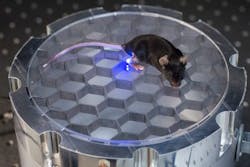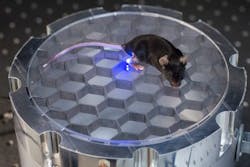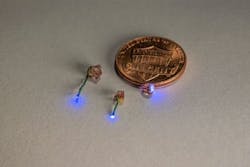Fully implantable device allows for wireless optogenetics
A team of researchers at Stanford University (California) has developed a miniature device that pairs optogenetics (using light to control the activity of the brain) with a new technique for wirelessly powering implanted devices. The device dramatically expands the scope of research that can be carried out through optogenetics to include experiments involving mice in enclosed spaces or interacting freely with other animals. What's more, it can be assembled and reconfigured for different uses in a lab, and the design of the power source is publicly available.
Related: Noninvasive optogenetics potentially promising for human applications
Traditionally, optogenetics has required a fiber-optic cable attached to a mouse's head to deliver light and control nerves. With this somewhat-restrictive headgear, mice can move in an open cage but cannot navigate an enclosed space or burrow into a pile of sleeping cage-mates the way an unencumbered mouse could. Also, before an experiment a scientist has to handle the mouse to attach the cable, stressing the mouse and possibly altering the outcome of the experiment.
These restrictions limit what can be learned through optogenetics. People have investigated a range of scientific questions including how to relieve tremors in Parkinson's disease, the function of neurons that convey pain, and possible treatments for stroke. However, addressing issues with a social component like depression or anxiety or that involve mazes and other types of complex movement is more challenging when the mouse is tethered.
Ada Poon, an assistant professor of electrical engineering at Stanford who led the work, had an idea to use a mouse's own body to transfer radio frequency (RF) energy that was just the right wavelength to resonate in a mouse. She and Yuji Tanabe, a research associate in her lab, worked to build a chamber to amplify and store RF energy. They then overlaid a grid on top of the chamber with holes that were smaller than the wavelength of the energy contained within, which trapped the energy inside the chamber. Because the wavelength is the exact wavelength that resonates in mice, the mouse releases the energy from the chamber into its body, where it is captured by a 2 mm coil in the device. Wherever the mouse moves, its body comes in contact with the energy, drawing it in and powering the device. Elsewhere, the energy stays tidily contained. In this way, the mouse becomes its own localizing device for power delivery.
This novel way of delivering power is what allowed the research team to create such a small device. The device is small enough to be implanted under the skin and may be able to trigger a signal in muscles or some organs, which were previously not accessible to optogenetics.
The researchers say the device and the novel powering mechanism open the door to a range of new experiments to better understand and treat mental health disorders, movement disorders, and diseases of the internal organs. They have a Stanford Bio-X grant to explore and possibly develop new treatments for chronic pain.
Full details of the work appear in the journal Nature Methods; for more information, please visit http://dx.doi.org/10.1038/nmeth.3536.
Follow us on Twitter, 'like' us on Facebook, connect with us on Google+, and join our group on LinkedIn


